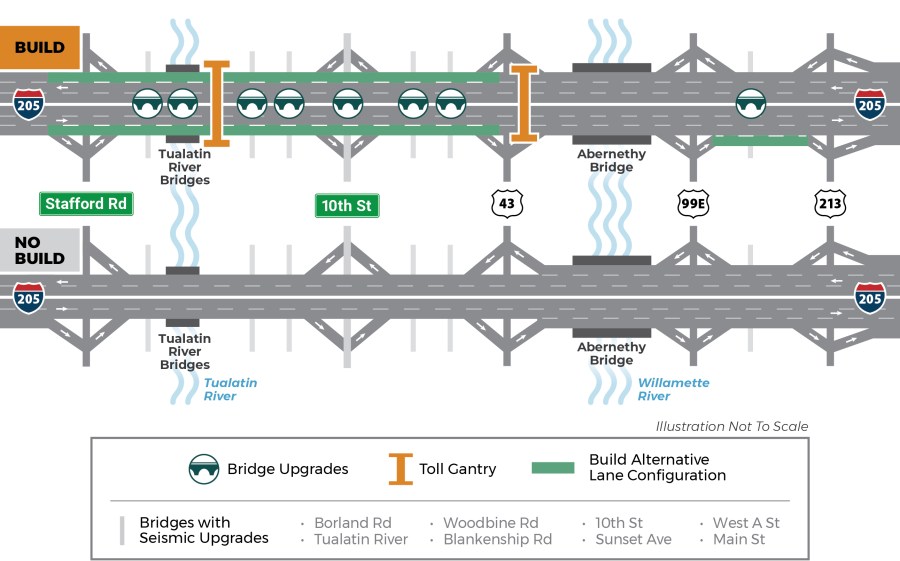PORTLAND, Ore. (KOIN) – Wanting answers for how the Oregon Department of Transportation plans to prevent a dramatic increase in street traffic following the rollout of the I-205 toll project in 2024, Clackamas County sent 36-pages of input to ODOT on April 20 questioning the methodology and conclusions of the state agency’s environmental assessment report published in February.
While ODOT eventually plans to toll all of I-205 and a stretch of I-5 in the Portland metro area, the introductory phase of ODOT’s expansive, new I-205 tolling system is expected to start in December 2024 between the Tualatin River Bridge and the Abernethy Bridge. With little word from ODOT on how it might prevent toll dodgers from flooding into the surrounding communities along the preliminary stretch of tollway, the proposed plan has local citizens, city and county officials fighting to have their concerns heard.
“The county’s primary concern is that the project does not plan for how to alleviate or mitigate the impact of all the traffic that will shift from I-205 onto county and city roads to avoid the tolls,” Clackamas County stated in an April 25 press release. “That jump in local traffic, which the EA acknowledges could be from 30% to 100%, will dramatically decrease safety and increase congestion on many already crowded local roads.”

A requirement of the National Environmental Policy Act, ODOT’s environmental assessment identifies potential long-term and short-term effects of the project on the proposed tolling project, including impacts on local communities, the economy, the natural environment, travel times, traffic and pedestrian safety. The assessment is also supposed to address the negative effects of the proposed plan. However, Clackamas County officials say that the state report’s solutions don’t give proper consideration to the area’s traffic concerns.
“The environmental assessment refers to mitigation measures, but they are minimal and inadequate,” Clackamas County stated. “For example: The only mitigation proposed for the Stafford Road/Rosemont Road intersection is to install a rectangular rapid flashing beacon to improve pedestrian crossing, but the entire intersection is projected to be failing by 2027. No measures at all are proposed to mitigate the increased traffic volume.”
The county says that the tolls are expected to triple the amount of street traffic in the area, reducing traffic safety and increasing the likelihood of car crashes. The county also states that even if there were solutions, there wouldn’t be enough time to implement them before the tolling project is planned to begin.
“Tolling I-205 is expected to add more than 3,000 vehicles a day to the rural Arndt Road, the equivalent of 10 years’ worth of traffic growth without tolling,” the county stated. “Again, there are no mitigation measures proposed to address this dramatic increase. And even the inadequate mitigation measures that are proposed are unlikely to be in place when tolling is scheduled to begin in late 2024 because there is not enough time to put them in place.”
In hopes of slowing the project and implementing more input from the affected communities, Clackamas County has requested that the Federal Highway Administration require further evaluation of ODOT’s environmental assessment.
“In consideration of the many deficiencies and negative impacts of the project reflected or omitted from the environmental assessment, Clackamas County is requesting that the Federal Highway Administration not issue a ‘finding of no significant impact’ for this project,” the county stated. “And direct ODOT to develop an environmental impact statement for this project, combined with the Rivers Management and Protection Program, to analyze the impacts of both tolling projects and provide meaningful opportunities for public engagement.”
Clackamas County’s additional concerns with the toll project include:
- Higher levels of stress for people walking and rolling along local roadways due to increased traffic
- Decreased access to local businesses in congested, unsafe conditions
- No decrease in greenhouse gas emissions, contrary to what is stated in the project, because there are no area alternatives to driving (like transit) and people will be driving longer routes on local roads to avoid paying the toll
- Severe impacts especially to low-income residents and other communities of concern who will either have to somehow pay the toll or travel on more congested, less safe local routes
- Significant aspects of the environmental review only covered areas within 100 feet of I-205, which means there was no analysis of impacts to important nearby places such as the historic Arch Bridge in Oregon City
- There has been no analysis of the cumulative impact of I-205 tolling along with the Regional Mobility Pricing Project (RMPP), ODOT’s next tolling project to toll all lanes on I-5 and I-205 in the Portland metropolitan area.
